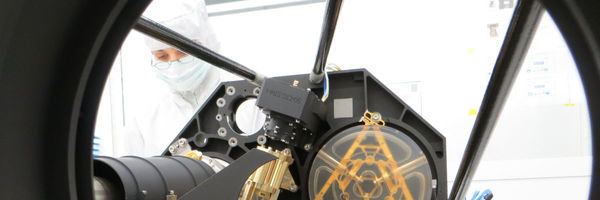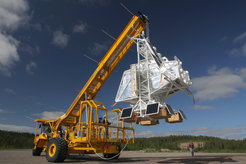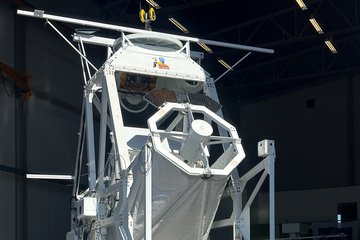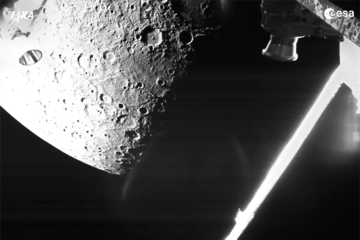
Working at the forefront of solar instrumentation
Scientists and engineers of MPS conceive new observing methods and develop novel instruments of highest technological complexity. These instruments are built in house, tested, calibrated, and used at the best solar observatories in the world, or delivered to NASA and ESA to be launched to space. Novel instruments will for the first time allow to capture the Sun in 4D, i.e., measuring the the spectral and spatial information of the solar atmosphere, encoded in the solar radiation, in one single shot.
MPS leads the development and later scientific exploitation of a solar space telescope for detailed studies of the magnetic fields on the solar surface, flying onboard the ESA/NASA mission “Solar Orbiter”, which will explore new ground, going very close to the Sun and flying over its uncharted poles.
MPS has also the leadership of the largest solar observatory ever to leave the ground, the 1m Sunrise solar observatory, which floats in the stratosphere on a giant helium balloon, looking onto the solar surface with an accuracy never achieved before.
Do you want to contribute to these missions at the forefront of technological feasibility?
Flying High: Deciphering the Secrets of the Sun with Sunrise III

Two successful flights of the Sunrise balloon-borne observatory (2009 and 2013) led to a plethora of new findings, published in more than 90 refereed scientific journal articles and in several PhD theses. The excellence of these missions was evaluated positively by multiple, highly-ranked panels, so that a re-flight of Sunrise is the logical consequence. After a failed launch attempt in 2022, we prepeare for a re-launch in June 2024. Sunrise III will again benefit from the unique observing conditions in the stratosphere at an altitude of ~37 km, free from almost any atmospheric disturbances and with access to the ultra-violet regime of the solar spectrum.
The on-board scientific payload will be completely revamped to the most advanced solar instrumentation ever leaving the ground: The absence of atmospheric refraction and the access to the ultra-violet spectral region (300-400 nm) allows for multi-line spectropolarimetric measurements, offering an unprecedented combination of polarimetric accuracy, and spatial, temporal and height resolution. A multi-line UV spectropolarimeter, a multi-line visible spectropolarimeter, an imaging polarimeter and multi-waveband slit-jaw camera systems will compose an instrument suite allowing for the detailed investigation of small-scale structures and highly-dynamic events from the deepest layers of the photosphere up to the upper chromosphere. In particular the UV polarimeter will explore a region of the spectrum whole polarimetric properties are poorly known. Many discoveries are expected.
In an international team led by MPS, with prestigious solar institutes in Europe, Japan, and the U.S., you will be part of this instrument development. Your tasks span from the simulation of the instrument performance using results from magneto-hydrodynamic simulations over the actual design and fabrication of the instrument to the recording and analysis of data from laboratory measurements and test campaigns at ground-based solar facilities.
A revolutionary hyperspectral imager for Solar physics
A hyperspectral imager is a dispersion based instrument that records spatial (imaging) and spectral information strictly simultaneously. At MPS we are developing a prototype of such an imager based on microlenses. Fabrication of the microlens array is underway, but once completed, needs to be tested and characterized. Once the prototype is completed, construction of a multi-segment instrument will commence that aims for a field-of-view of 15x15 arcseconds, large enough to image elementary solar structures. This instrument is designed to allow for image restoration of spectra and is thus particularly well suited for ground based observing.
In this PhD project, you characterize the new prototype instrument and learn how to observe with an instrument of this type, of which no other instrument currently exists at any solar telescope. The new data will access a new regime in the domains of time cadence and signal-to-noise, yielding access to a thus far unexplored region of parameter space.












